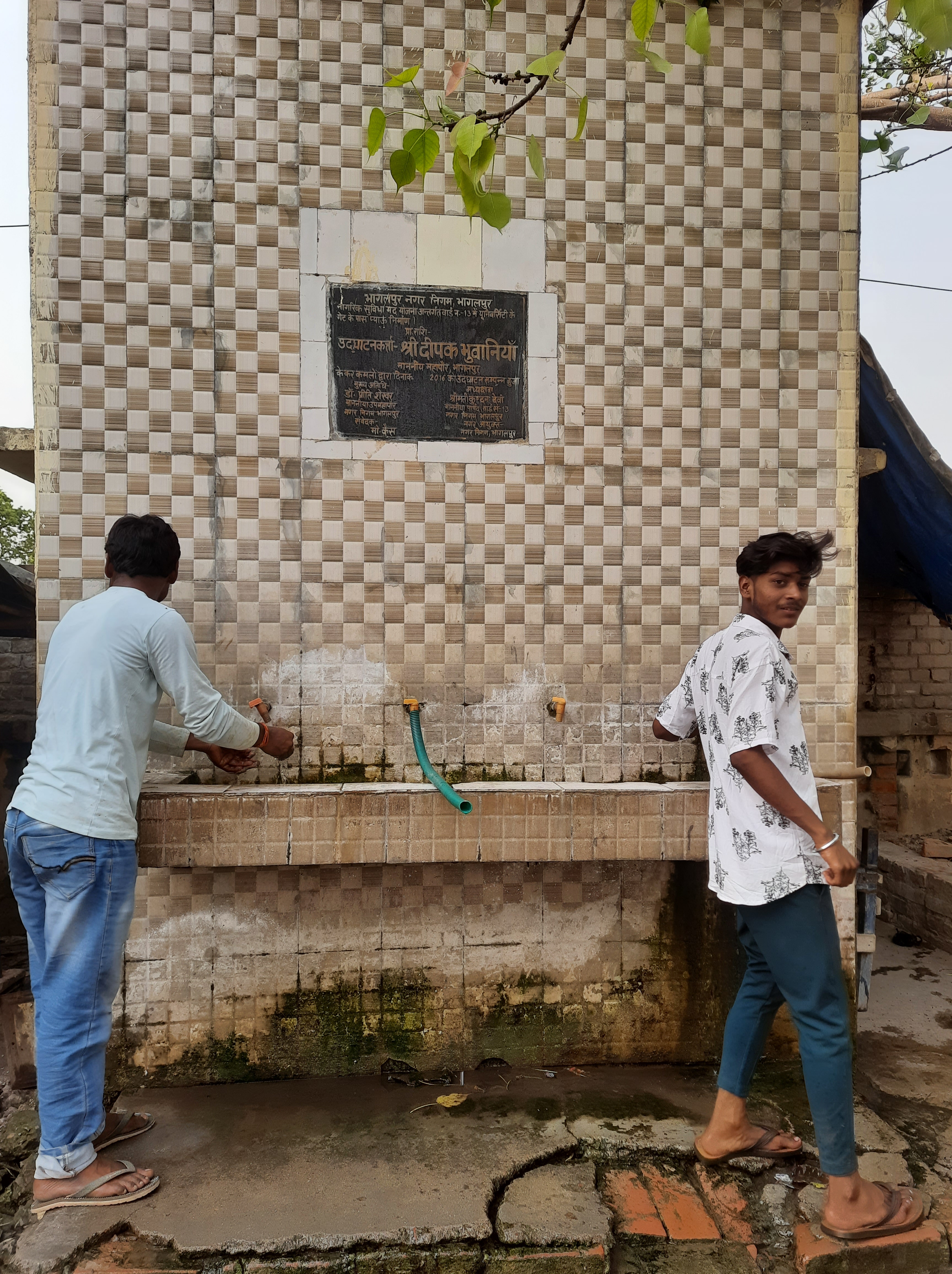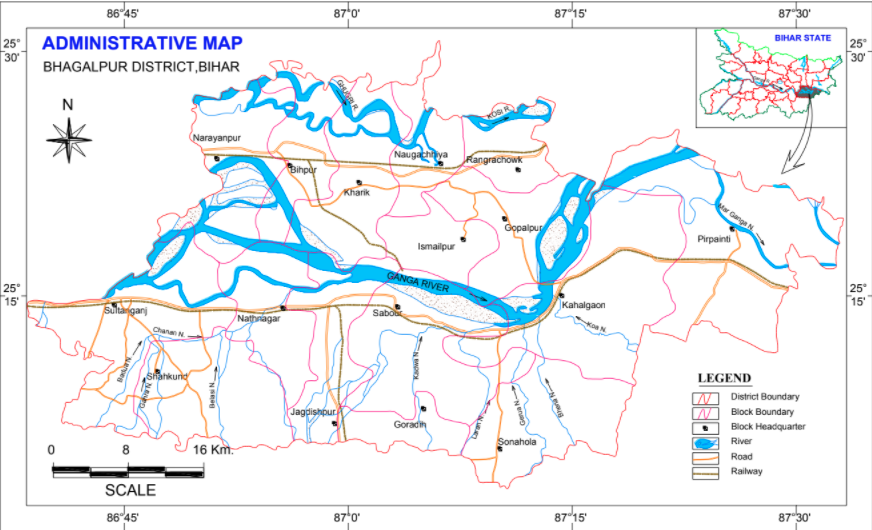Guest Blog by Dr. Ruchi Shree (TMBU, Bhagalpur-Bihar)
Last year, I wrote three stories on dying Champa river in Bhagalpur and challenges/ prospects of its rejuvenation[i]. That exercise helped me in exploring the city through a river which used be an important waterbody in this region but now at the verge of extinction. Situated at the banks of river Ganga, the Bhagalpur city faces three to four major problems related to water and sanitation, namely, arsenic contaminated groundwater, falling water level, recurrent floods, open drainage, etc. This year, I pedaled (cycling) in the local vicinity to make sense of ‘piped water’ and its limitations in the city. One more concern was to document the growing ecological crisis in the university area as captured and reflected in this blog. This photo essay is based on my observations over a period of last three months in Nathnagar block of Bhagalpur (south-west part of the city). Bhagalpur, a “smart city” of south Bihar is close to Jharkhand. I visited the ward no. 13 and ward no.17 of the Nathnagar block to write this story. Two pictures (near Ganga) towards the end of the blog were taken in a different part of the city i.e. in Adampur area of Bhagalpur.
Glaring Inequality The glaring inequalities in the society are alarming, especially when it comes to access to clean drinking water or to have water throughout the day which has now become popular as ‘24×7’. One often gets to see water containers on mini trucks, bikes and cycles or even people carrying water containers in their hands. While cycling from my workplace to residence, I was intrigued by the view of a unique and quite innovative carrier with four small wheels. I was startled by the fact that those carrying water were two children aged merely five to seven years. One more thought flashed in my mind that it is rightly said that ‘necessities lead to innovations.’ No wonder, since it is difficult for young children to carry water in their hands or on their heads, this innovative water carrier seemed a boon.


Another day, I came across a woman around sixty years old washing her clothes at 3 PM at a borewell on the roadside. Three to four girls aged between twelve to sixteen or eighteen were standing there to fill their water containers. I stopped to interact with them and to get a sense of their ‘water routine.’ This term I am using for the time devoted for water collecting and storing which is an everyday affair.

Mostly women and Children are water collectors The female correspondents were surprised by my questions viz. who collects the water in family, is it on a rotation basis for one or the other family member or had a fixed person as the ‘water collector’? How much time they have to spend on water? They asked me whether I was a journalist and if their pictures will come in newspapers or they are likely to have water connection in each household in near future due to this interaction with them. In fact, some of them were aware of ‘har ghar nal ka jal yojna’ of Govt. of Bihar which promises tap water for every household.

It was quite disturbing to learn that on an average, everyday three to four hours are devoted for carrying water from the borewells on the road (by the municipal corporation) to their houses. Their daily chorus and the dependency on these borewells differ from family to family. Some of them have chapakals (handpumps) in their house but the water is not fit for drinking. Two to three of the correspondents mentioned the drying or scanty water availability in the handpumps due to falling water level. Vimla Devi, aged 55 and Kalawati Devi, 60 years old who live in the adjacent colony named Company Bagh, shared their agony over no access to water at their house.

Depleting groundwater in the city of Ganges Some dry handpumps in the area tell us the worsening realities of water. I interacted with three to four correspondents about the issue and they reported the gradual decline in water level. They said that excessive extraction of groundwater has led to receding water level. Ten years back, water was available at merely 10 to 15 feet below the ground which is now beyond 100 feet in this area. Many people have switched to submersible pump for pumping the groundwater. As a result, over extraction of groundwater is rampant.

Let me deviate your attention to growing ecological crisis in this locality. The dumping of garbage and sewage water flowing in wide open is hazardous. A huge drain flows wide open in the University premise’s administrative area and it is full of dirty water and plastics. Walking along the drain one gets filled with bad smell of degrading plastics and also due to open defecation quite prevalent in this area.



No provision for dustbins? There is a small pond in the Lalbag Professors colony of Tilka Majhi Bhagalpur University (situated in the Nathnagar area) and to my utter surprise the dirty water of this area is dumped into that. Alarming was to see some dead fishes floating in the pond water during the morning walk last week. Around the pond, the residents (sadly, including myself) dump the garbage at the corners of the pond and my attempt to reach the deputy mayor of Bhagalpur and councilor of this ward was not of much help. I called them to request for a few big dustbins for this residential campus and to ensure that the garbage could be collected on an everyday basis. I was told that the dustbins are not being supplied to them thanks to the Covid-19 Pandemic.


The Dirty Ganga The flowing Ganga is partly visible from the terrace of the building in which I reside in the Lalbag campus (at a distance of around two kilometers or so). However, few months back, the desire to have a closer look at the Ganga and to feel its presence led me to visit a nearby ghat made by the Municipal Corporation of Bhagalpur. The word Ghat is used for an area which gives access to river (for bathing, boating, etc.) and it is usually a descending path or stairway to the river. The ghat I visited is named ‘Seedhi Ghat’ near the Sundarvati Mahila College (famous as SM College in this region) was constructed in 2012. The filth, dirt and the stink near the ghat was unbearable and it was difficult to be with Ganga for even five minutes. You may imagine the same by looking at the picture given below. I was told by the local people that the ghat is cleaned once a year to perform the Chhat Puja but rest of the year it remains dirty. I could relate to it since it was quite evident by the garbage dumped there.


To Sum up This narrative could be seen depicting a paradox of ‘abundance’ and ‘scarcity’ of water in this region. On the one hand there is flowing Ganga as the lifeline of the city and on the other the Central Groundwater Board (CGWB) Report (2013) on Bhagalpur enlists the problems such as critical arsenic contamination in some areas, falling level of groundwater, limited access to drinking water (as depicted above in pictures of drying of hand pumps, people carrying water, etc.). This story can also be seen as a convergence of ‘macro’ and ‘micro’ aspects of water distribution in the city. It is unfortunate that the dirty water of the city falls into the Ganga and its tributaries viz. Champa river and even to the ponds in the local area. In present time, when the ‘river rights framework’ (rivers as a living entities) and the concepts such as ‘water justice’ and ‘water security’ are gaining momentum worldwide, one needs to take cognizance of the worsening realities around environment in general and water in particular.
As UN begins the decade (2021-2031) of Ecosystem Restoration on the World Environment Day on June 5, 2021[ii], stories like that of Bhagalpur shows the enormity of the task ahead and need to start this work of ecosystem restoration urgently, halting the ecosystem degradation at the same time.
(By Dr Ruchi Shree (jnuruchi@gmail.com) for SANDRP on the Environment Day, 2021)
End Notes:
[i] https://sandrp.in/2020/04/05/how-did-champa-nadi-river-in-bhagalpur-bihar-become-nala-drain/,
https://sandrp.in/2020/04/12/champas-angpradesh-to-champa-nala-of-bhagalpur/,
Bringing Life back to Champa River
[ii] https://www.unep.org/events/un-day/world-environment-day-2021

अच्छा, तथ्यात्मक और जरूरी लेख है। बधाई रूचि श्री को।
LikeLiked by 1 person
Thank you Yogendra Sir
LikeLiked by 1 person
This sounds like an absolutely disastrous situation.
Why can the deputy mayor of Bhagalpur and councilor of this ward do more to sort this situation out? Why can’t local education programmes be put in place to educate the local citizenry about the dangers of dumping their garbage on the local water supply. Also, it sounds like the groundwater table is running into serious difficulties.
Action, action, action … thank you for your work on highlighting this situation and for SANDRP for their invaluable efforts in trying to improve the water situation in India.
LikeLiked by 1 person
Terrible situtation. A lot more could be done, especially on littering of the waterways which is an educational issue. The provincial authorities need to get on top of this situation, particularly with regard to falling groundwater levels e.g. borewell recharge, rainwater harvesting measures. It sounds like one big mess. http://www.rainwaterrunoff.com
LikeLiked by 1 person